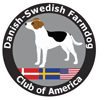Taking Pictures to Show Your Dog
By Helene R. Pedersen
There are many ways of taking pictures of dogs, which make for fun and unique memories. But there is really only one kind of picture, which can show the dog's proportions and give a hint about it's quality. These kind of pictures can be useful or helpful for breeders, to evaluate i.e. their own off spring, a male dog for possible breeding, a female they might want to consider buying a puppy from sometime, or the breeding value of the dog's parents, etc.
Mostly a series of pictures is necessary, as "the perfect picture" is next to impossible to get. The series of pictures should include:
- Standing dog pictures taken straight from the side
- Standing dog pictures taken from the front and/or 3/4 shots
- Head pictures, profile and frontal pictures.
Standing Dog Pictures
Standing dog shots taken straight from the side of the dog, from a level equal to the dog (not from above, and not from below).
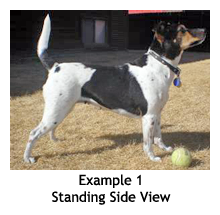
Here is an example of a good side shot taken almost straight from the side. The dog is standing rather well on it's own, and is relaxed so the picture gives a good idea of the dog's natural top line, underline, and proportions length/height etc. It also give a good prfile of the head, and it shows the dog's forechest (or lack of). The dog is alert, head an tail up.
In the perfect world, the dog's hind leg would have been placed slightly further forward, so the leg from the hock to the paw would have been at a 90 degree angle to the ground. The dark shadow behind the dark head makes it a bit hard to see the head's profile clearly.
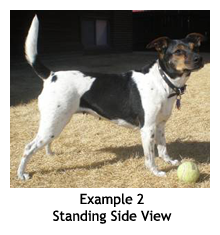
Here is another rather
good side shot, from when the dog turned the head a bit.
It shows the head in a 3/4 format, part front and part
side. The photographer moved slightly more towards the
front of the dog, than in the picture above.
In the perfect world, front legs and rear legs are better aligned with one another than here, but it is "ok" in particular if other pictures of the dog are along in a series accompanying this picture.
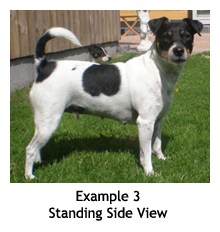
A very good side shot, this picture shows the dog's head from the front, versus in profile, and the angle of the bottom part of the rear leg to the ground is really good, very close to 90 degrees.
The grass should not be any taller, the picture's weaknesses are the disturbing head of a different dog right "above" the back of the dog being shown, and the grass covering the paws, leaving a little bit up to the imagination, as far as the dog's proportion length/height.

Here is a picture which unfortunately looses most of the essential information about the dog, because it is not taken straight from the side, but too much from behind the dog.
Standing Dog Pictures Front and/or 3/4 Views
Showing the front of the dog, giving (among other information) an impression of it's body width. The dog should be in the same alert, but relaxed and balanced position as for the side shots.
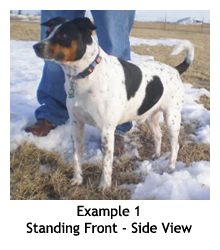
Here is an example of a so-called 3/4 shot. Both the dog's body and head is showing in a 3/4 format.

Another 3/4 shot. This picture looses a bit because the dog's paw is lifted, but it's still "ok", in particular if other pictures of the dog come along with this picture in a series. This picture also shows this dog's head almost from the front, pretty well.
The length of the grass is a weakness in this shot, because the length of the legs can be difficult to determine.
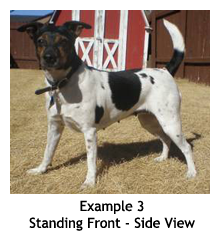
Another example of a 3/4 shot. In this shot the dog is sticking the front legs out to the sides, which disturbs the picture some. It is a good picture for showing the dog's head from the front though, and again, if combined in a series of pictures, along with other pictures of the dog, it is an "ok" picture.
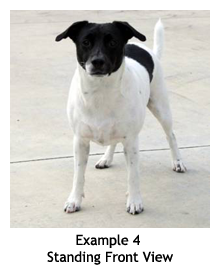
A Rather good frontal shot. It should not be taken from any higher position, this is a good picture and shows what it needs to, but it is actually taken slightly from above the dog! Any higher position of the camera would make it too high and useless.
This is also a good frontal picture of the head.
Head Pictures - Profile and Frontal
And the series of pictures should also include some pictures showing the dog's head. One frontal and one profile. Some of the body shots can also show both, so if you have a lot of the side shots showing the dog's head's profile, take some of the dog's head from the front in addition, and vise-versa, if you have the dog looking straight at you giving good frontal head views on the side shots, take a profile picture or two, of the head in addition to those.

Example of an almost frontal head shot, which is very considerate of the dog's color ... because the black head is pictured with a light back ground, which really helps showing what it needs to show.

A good profile picture of the dog, showing the head's proportions rather well. It could have been taken just a tad more from the right, for the perfect profile, but it is "ok". This picture too is considerate of the dog's dark head, in placing it in front of a white back ground.
If taking perfect pictures only 3 shots would be needed, but typically a series of shots in each category, will be most helpful to the person trying to evaluate a dog and get an impression.
Consider it is only the dog you are taking pictures of, and allow the dog to "fill out" the entire picture. Back ground objects and scenery is of no interest, and only disturbs the picture. If the dog is taken from too far of a distance, the picture's value also takes a dive.
You want the legs pair wise to be parallel and besides the bottom of the rear legs being in a 90 degree angle to the ground, you want the front legs to be set right below the shoulder, which is a natural and relaxed standing position. You want to observe that the dog is not either leaning forward (as in pulling at the end of a leash) or leaning backwards as if looking up into the sky above it, or on the way to taking a "sit" position. In both cases the dog's lines get disturbed.
These pictures can be taken with the dog standing on a table, only sometimes it is difficult to get that "perky look" when inside and on a table, unless the dog is used to it. Consider you want to try to take good pictures of your dog, so help it with the environment if need be.
Often the dogs will take a natural posing position, head and tail up, if spotting something of interest from a distance. Those situations can be "staged" if outside i.e. in a park, and if having an assistant holding the dog on a leash. With some patience, and without too much coaching or "fuzzing", the dog will usually take good standing positions all on it's own.
On a table an assistant can be helpful too, for holding treats or toys, and/or making sounds, to get the dog's attention.
They show themselves best with head and tail up, if it doesn't work, consider changing the surroundings from i.e. inside to outside or vise-versa.
Always remember that pictures are good, but that they only tell a small percentage of the whole story ...temperament and height cannot be shown or viewed in a picture, and neither can a dog's angulation or gait. Those are all major ingredients in the evaluation of the quality of any dog, therefore pictures can be extremely helpful, but alone they are not at all sufficient for making i.e. breeding decisions.
Happy posing picture taking practice!!!
